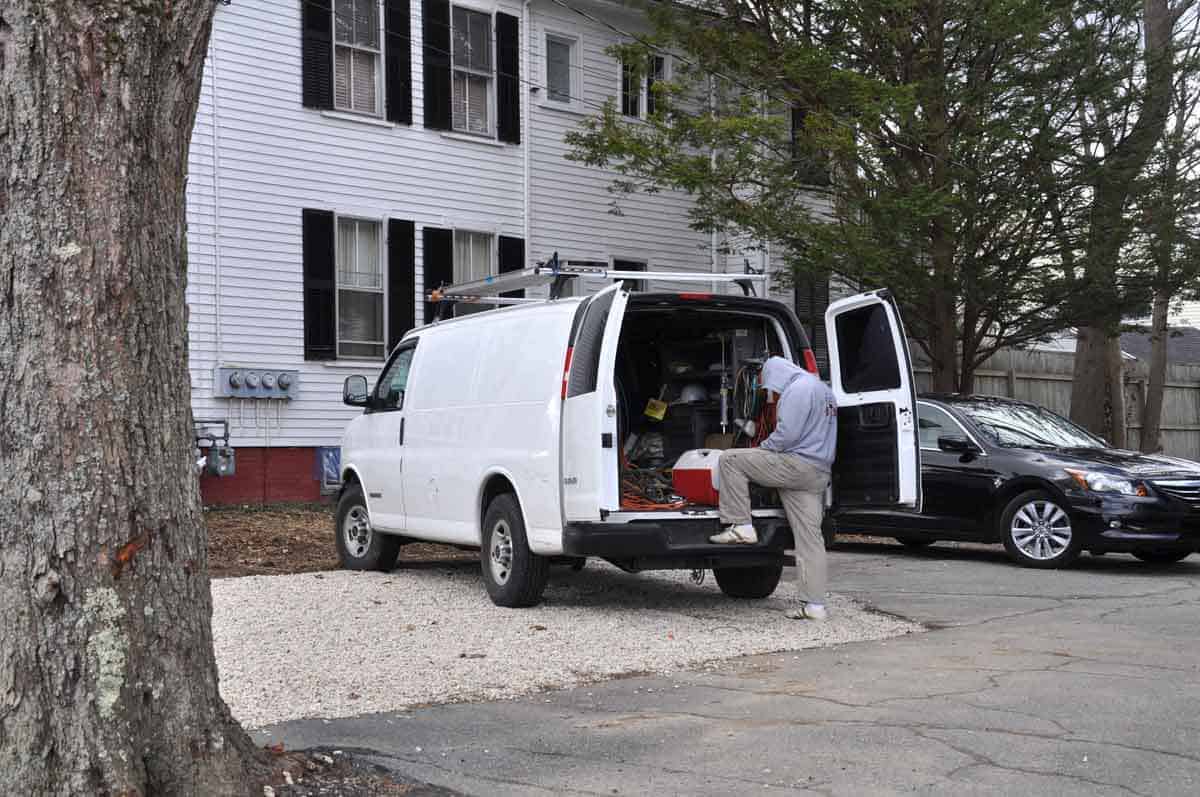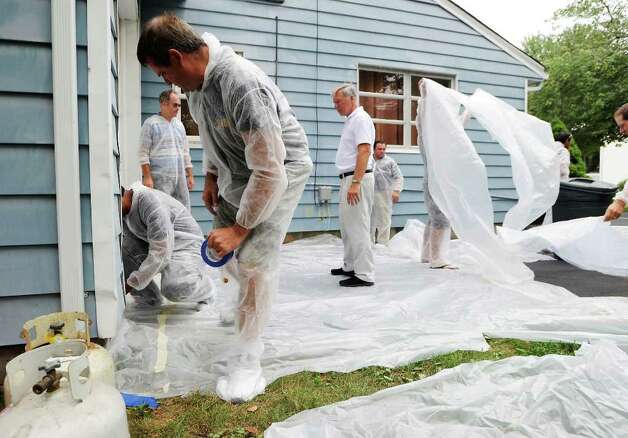 According to Wikipedia, lead paint has been produced since the 4th century BC. Lead in paint speeds up the drying process, helps maintain a fresh appearance and increases durability. In fact lead is still being added to paint in many countries around the world, often by US companies according to the Huffington Post article, Lead Paint & Other Toxic Products Banned in US, Still Exported to Unsuspecting Customers Abroad.
According to Wikipedia, lead paint has been produced since the 4th century BC. Lead in paint speeds up the drying process, helps maintain a fresh appearance and increases durability. In fact lead is still being added to paint in many countries around the world, often by US companies according to the Huffington Post article, Lead Paint & Other Toxic Products Banned in US, Still Exported to Unsuspecting Customers Abroad.
Even though the dangers of lead paint were identified as early as 1904, it took a long time for the government to make the sale of lead based paint illegal.
- In 1977, lead paint was banned by the US Consumer Product Safety Commission in residential properties, public buildings, toys and furniture.
- In 2008, the Consumer Product Safety Improvement Act lowered the cap on lead content in paint, from 0.06% to 0.009%. It focused on products for children under the age of 12, covering apparel, shoes, personal care products, jewelry, home furnishings, bedding, toys, electronics and video games, books, school supplies, educational materials and science kits.
- In 2010, the Environmental Protection Agency established the Repair and Painting Rule requiring all contractors doing Repairs, Renovations or Painting (RRP) in homes, child care facilities and pre-schools built before 1978, to be trained and certified for lead-safe work practices.
 Who Benefits from the Rules About Lead Paint?
Who Benefits from the Rules About Lead Paint?
This story started in Portsmouth, NH when I was visiting friends. While driving down the street several blocks from where I used to live (take a peek at my Victorian), I realized there was a house being painted, and I knew lead paint had to be involved because the house was older based on where it was located.
Turning around, I went back to take photos and discover if the painters were using proper lead safe procedures. My motivation was two-fold.
- It was time to write about RRP again, and how the rules have affected contractors (sold my handyman business four years ago).
- More important, I wanted to see how I could help homeowners identify problems and report lead paint violations, because I was reading a lot more stories about lead poisoning.
But first, let's look at who benefits when lead paint rules are adhered to.
- Homeowners and/or renters who know their house has not been contaminated with lead dust.
- Neighbors who can also be affected by lead chips and dust, especially when work is being done outside where wind can blow materials (and lead dust) onto their property.
- Contractors and their families, as without protective gear and clothing, would be exposed to dust all day and then take it home with them.

Talking with Contractors About Lead Paint
When RRP started, I owned a handyman business in southern NH. Like most contractors, I felt the required procedures, paperwork and cost were an unfair burden. Employee training would cost of $600/handyman, plus company registration and extra insurance quoted at $1,000/yr and homeowners didn't want to pay for these added costs.
I now understand the devastation caused by lead paint poisoning. That in large part is due to meeting Tamara Rubin, and learning about her non-profit, LeadSafeAmerica.org (searching for family stories). So here's what happened:
- First I parked across the street from the painting project, and took several photos.
- Next I walked down the street to capture the license plate of the painter's van, as reputable contractors typically advertise their businesses on their trucks and this van was plain white.
- Then I went up to the guy by the van and asked if the (business) owner was there, as I wanted to talk to him. He said no and appeared to be calling him when another man came up to talk … and that's when things got interesting.
- The man tried to intimidate me by asking who I was, and why I was there. I explained but unfortunately had just run out of business cards to support my story.
- Then another man came up and said he was the homeowner (looking back, I don't think he was), and told me he'd been given the required documentation and understood the lead paint safety procedures.
- We talked about the requirement for plastic and I could see some lying around the house. As I was trespassing and out of time, I didn't press the issue too far and left.
What I wish I had done was just ask if I could take some photos so I could write a story. I believe their response would have told me right away if they were, or weren't, following all the steps required.
I was also mad at myself for not knowing exactly what the exterior requirements are (training focuses more on inside painting and repairs). but not as clearly as the photo below. That's why a camera is perfect, because it can zoom in and give you much more detail than the naked eye (not sure about smart phone cameras but I'll be testing them too).

Documenting Lead Paint Rules for Homeowners
Yes, there is lots of documentation about the RRP rules but they're cumbersome, and even if you've read them (or been trained like I was, but 5 years ago), you're not going to remember the details. So my goal is to create a simple reference card with photos and basic lead paint facts, something I can carry with me … and LeadSafeAmerica.org and give out with their lead paint test kits.
And if you're curious about how much plastic should have been wrapped around this house, here's a photo showing the RTK Environment Group teaching a class in Stamford, CT … and it looks more like the 10 feet I remember (but have to verify).

 Who Benefits from the Rules About Lead Paint?
Who Benefits from the Rules About Lead Paint?



My responses to Tito’s comments are inline, preceded by …
First I parked across the street from the painting project, and took several photos. Creepy.
… I often stop along the side of the road to take photographs of houses to support the articles I write on this website. I don’t think it’s creepy unless you’ve got something to hide.
Next I walked down the street to capture the license plate of the painter’s van, as reputable contractors typically advertise their businesses on their trucks and this van was plain white. This is a common practice if you don’t want your painting supplies to get ripped off.
… That’s possible but think I’ll talk to my painting friends for their opinion. I actually know the majority of the painters around Boston are Brazilian, most of them in the US illegally, which is the bigger problem they’re hiding. The same is true with roofing crews, where owners hire them promising a green card but firing them just before their one year anniversary.
Then I went up to the guy by the van and asked if the (business) owner was there, as I wanted to talk to him. He said no and appeared to be calling him when another man came up to talk … and that’s when things got interesting. Here is where you should have gone home and called someone. You have no badge and no authority. People like you are exceptionally annoying to the rest of us.
… You’re correct that I have no legal authority but I have taken the RRP training. I was trying to experience what a typical woman homeowner might experience so I could write about it, and recommend what they should do. When I wrote this article, there weren’t any phone numbers to find online easily but there are now, so thanks for reminding me to write a new article specifically on how to report RRP and other suspicious contractor activities.
The man tried to intimidate me by asking who I was, and why I was there. I explained but unfortunately had just run out of business cards to support my story. You are spying on and stalking a painter but consider someone asking you who you are and why you’re there to be “intimidating” you? Please.
… I might not have had a business card but I did provide my name & email address, to which someone worried enough to have a lawyer send me a threatening email. I talk to lots of people when taking photographs, providing a business card and none has reacted this way because they didn’t have anything to hide.
Then another man came up and said he was the homeowner (looking back, I don’t think he was), and told me he’d been given the required documentation and understood the lead paint safety procedures. In other words you wasted his time.
… Making sure homeowners understand the risk of lead paint is never a waste of time.
We talked about the requirement for plastic and I could see some lying around the house. As I was trespassing and out of time, I didn’t press the issue too far and left. You sound like an annoying busybody.
… I appreciate this dialog as everyone is free to have their own opinions. What I find useful is your comments highlight characteristics of contractors that homeowners should avoid, as I believe in hiring contractors who are open to dialog, to explaining what a job entails and how homeowners can stay involved throughout the job.
My comments were included above, so I could reply to each point made …
If you’ve never seen lead paint removal done the right way, here’s a photo showing how the entire area has to be wrapped in plastic to minimize the amount of lead dust that escapes.